Ghost Town: The Growing Number of Vacant Storefronts in Tribeca
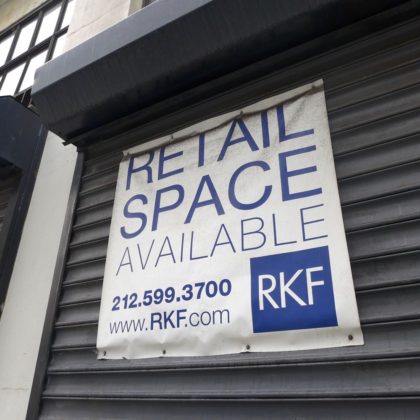 Last August, I counted 100 available retail spaces in Tribeca. This year, there are 129.*
Last August, I counted 100 available retail spaces in Tribeca. This year, there are 129.*
This is sure to inspire comments about “greedy landlords,” but the landlords lose money every month their storefronts remain vacant. Asking rents are clearly too high—landlords think their storefronts are worth more than they are—but as one broker I spoke with pointed out, there’s just enough activity to keep hope alive: “Landlord #1 hears that landlord #2 was able to get $150 per square foot, so he wants to wait, even though his space is worth more like $80.” There are likely other factors at work. As another broker explained, a lot of landlords get financing with high expected rents as part of the equation. No one wants to admit he or she overpaid, and it’s not in a landlord’s interest to only make enough rental income to pay the bank—so, in a twist on a banking term, better to extend and pretend.
There has been talk of a softening in the retail market elsewhere in the city, but we’re not seeing it yet. What I wrote last year still feels applicable—and only more so as FiDi turns into a massive mall: “Even if Tribeca continues to get aggressively developed, it will never be a high-density neighborhood when developers keep building 4,000-square-foot, single-family apartments. And the lack of corresponding foot traffic is what caps the amount of money any business can make here. You could argue that workers from FiDi will help fill the void, but there’s an obscene amount of retail coming online to the south—at Brookfield Place, the World Trade Center, the Seaport District, the Fulton Center, 28 Liberty…. That’s also where chains are going to want to be, because tourists are there, too. Tribeca then gets left to the independent businesses. Of which there are fewer and fewer….”
*The methodology is the same as last year. The area surveyed is bounded by Canal, Broadway, Murray, and West. I did not include the spaces where we know something is coming; new or not-yet-built buildings where the amount of retail is unknown; pop-ups and other temporary retail (such as condo sales offices); or anything on Canal, because that’s an entirely different ecosystem from the rest of Tribeca—although it too is decimated, especially the north side.
UPDATE 8/24: The good news is that there are only 127 now, first because Pixel Academy is moving into 256 West, and 8 Jay is very much still the home of Artflag. (I erroneously assumed it was still on the market.)
Northwest Tribeca
Southwest Tribeca
Northeast Tribeca
Southeast Tribeca








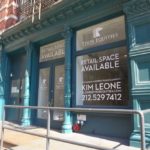


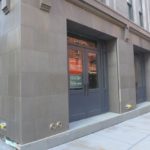

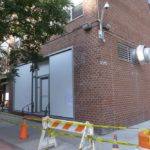

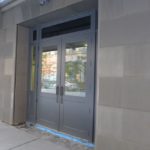
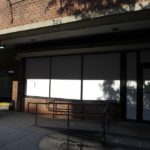
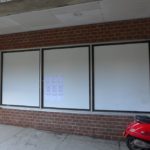
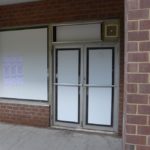
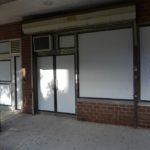

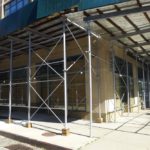


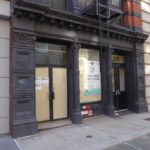
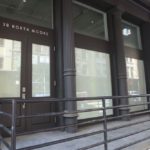




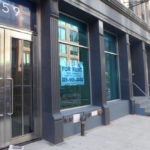

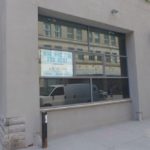
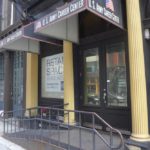

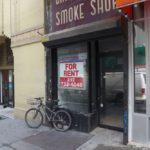
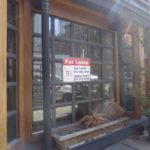
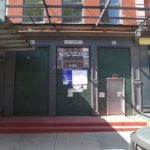

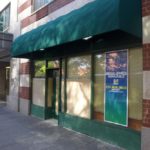
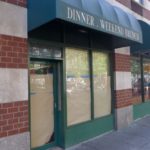
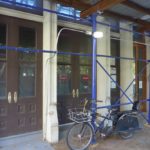
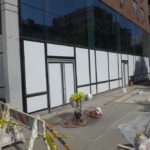


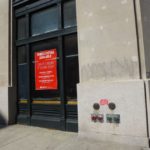
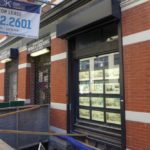


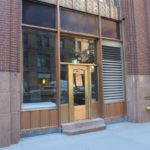
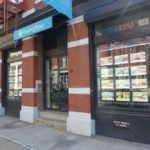
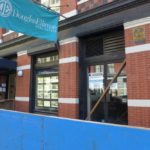


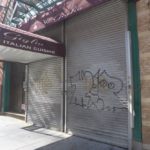

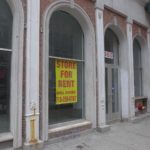
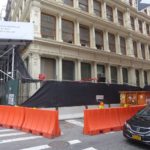
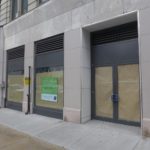
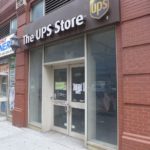
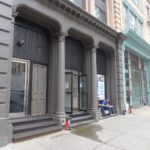
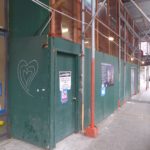
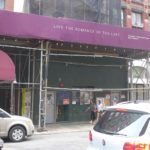
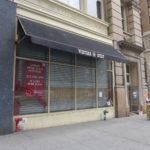
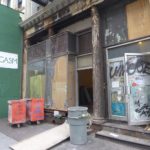
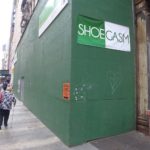
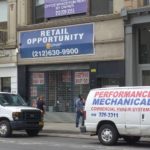
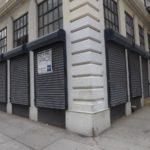
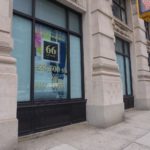
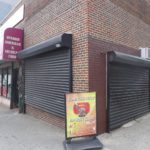

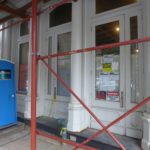
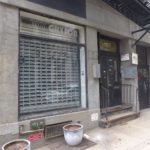


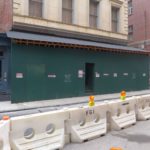

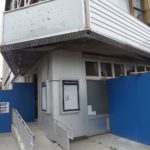

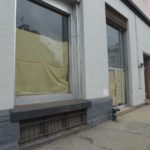
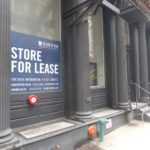
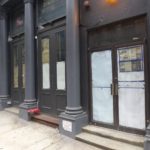
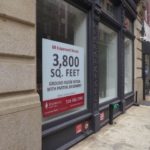

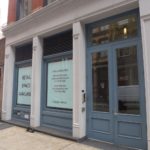
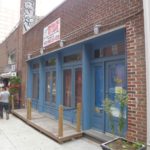
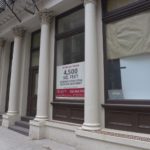
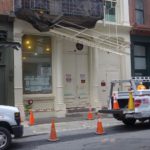
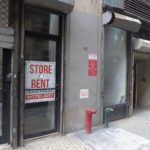

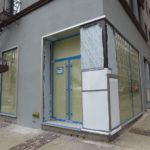
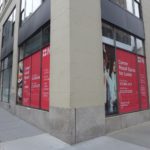
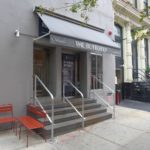
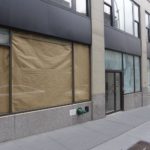


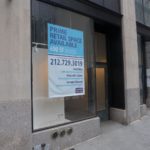
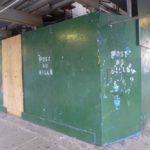

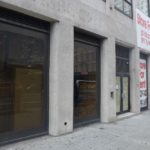

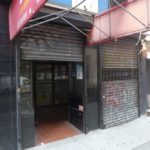

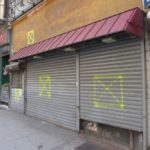


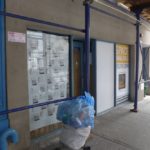


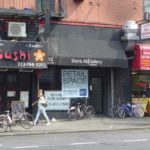
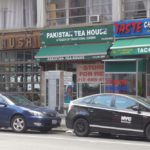
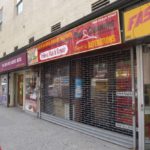

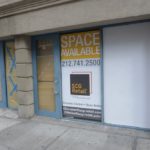
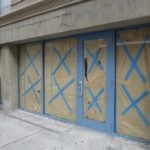
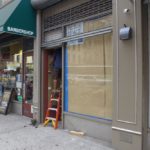
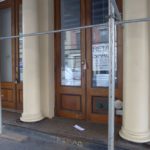
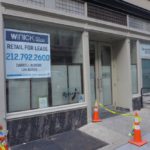

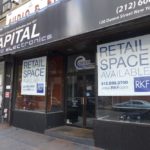
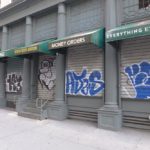
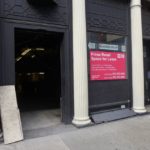
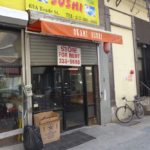
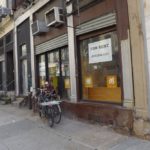
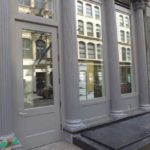
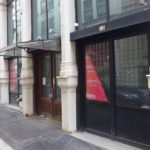
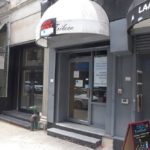
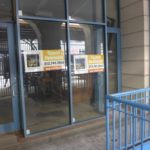



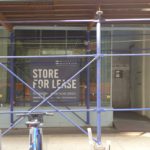









Good Summary thanks
… not to mention the block where Racoon Lodge et al have been evicted. You just KNOW nothing will happen and it will be a boarded up eyesore in the heart of Tribeca for years not months. Neighbourhood should be a mecca for small businesses, not this worsening state of affairs. Good journalism
Those buildings are coming down for a new condo development. Unclear how much vacant retail the new building will have
Storefronts may be vacant but greedy landlords are not dropping rents yet, but they will soon, as banks and retail clothing stores drop retail locations in the face of online buying.
Someone said this earlier when a similar article came out and it really stuck with me: very soon, residents of Soho and Tribeca will not have a place to eat lunch or dinner due to crazy high rents and being forced out. If you want a meal, you will have to taxi, walk or subway somewhere in midtown.
How many burgers or salads do you have to sell each month to offset a rent of say $15-30K?? That’s a LOT of burgers!
The ONLY reason this is happening is greedy landlords who have been assuming, wrongfully so, that trees can grow to the skies and that they can just keep raising rents each and every year and assuming tenants will just have to suck it up. I have the view that this trend will end up biting landlords in the arse with more and more empty retail spaces and more and more businesses bringing their business elsewhere.
If landlords/managing agents in Tribeca/Soho charged more realistic rents, they would not be stuck with so many vacant spaces. The worst thing a landlord can have, besides a place that’s not rentable for months, is a space they thought they leased with a long term agreement only to have a tenant bail on them because the business model didn’t work. More often, than not, the culprit is a small businesses’ ability or inability to make the monthly rent demands.
Perhaps its time for landlords to rethink the business model on their end and look to work with their tenants and offer up lower rents vs the inevitable empty space, but this being NY real estate, something tells me that will never happen.
Excellent article. There is an additional reason for the high number of vacancies–Tribeca is a neighborhood in transition and both the potential tenants and the landlords are aware of the situation so both parties are holding back on consumating deals until the transition happens. Another factor is the amount of construction and resultant scaffolds (particularly on the Broadway corridor) that discourages deals from being inked at this time. Be patient and you will see the Tribeca storefronts blossom in the near future.
If by “transition” you mean the rapid development of tall, glassy buildings marketed to foreign owners as pied-a-terres, then we are out of luck. Retail all comes down to foot traffic, and it will be very hard to compete with the developments to the south.
Transition to what?
run the story on iphone spelling of tribeca again, then ask yourself is it really so surprising the hollowing out of the landscape continues unabated…..really. vapid ghetto.
Great article. We love the area and our customers, but rents are increasingly difficult to navigate.
After Erik’s first 100 storefronts a group of retailers got together and formed The Tribeca Alliance, of which I’m a member. We need more small businesses to join as there is strength in numbers. We have some upcoming events that might help . Contact us at tribecaalliance@gmail.com or check out our website: tribecaallance.com.
Jean Grillo, Community Liaison
Tribeca Alliance
hear that hissing sound? that’s air leaking out of the real estate bubble!
Why wouldn’t these landlords just convert this empty commercial space into apartment rentals with short leases? It can’t be that expensive to put a small kitchen and full bathroom in each unit.
Zoning….
Zoning battle. Likely the city would not approve change in zoning, since the city make enormous property taxes from commercial sites, while giving more and more concessions to residential zoning (all those new developments with tax abatements, etc. and cap of 6% annual increase for residential property tax rates vs no cap for commercial rates). City budget keeps going up and up, something’s got to give. Commercial properties have had to shoulder a greater burden than the residential ones (although residential property taxes are high too).
There have been plenty of changes of use and zoning and/or zoning variances granted by the BSA in Tribeca for residential uses otherwise prohibited by zoning resolution on the 1st floor. These include new construction and conversions of existing space. However, these areas seem to tend to be the streets where the conversion is from manufacturing or office, with little to no existing retail use:
Greenwich near Canal; Desbrosses; Vestry; Laight; Washington; Franklin west of West Broadway; Duane and Reade, both west of Hudson; Walker and Beach; Lispenard.
BSA would likely not easily grant a variance for 1st floor residential on predominantly retail streets like Chambers, Church, West Broadway, Sixth Avenue.
Changing the legal use (to and from retail) takes time and lost rent to get DOB and BSA approval. I would bet most of the first floor residential use is co-op or condo, and not (non-rent-regulated) rental.
Of course this article will inspire comments about “greedy landlords” because that’s the reason for all these empty storefronts.
The neighborhood has become an urban suburb where all there is to do is shop, eat, and drink just like any suburb.
So what you’re saying is…greedy landlords.
Maybe it’s time for rent-control on commercial spaces.
Does anyone know what the deal is with the storefronts on the South side of Chambers, just past The Patriot? The first was a Popeye’s Chicken when I first moved to the neighborhood but it’s been empty for about 10 years! Next to it has been empty just as long. I have never understood how that can be. Are they contested spaces? Has the owner passed and noone has claimed it? I don’t get how it stays empty. Thanks.
The last we heard anything about those buildings, the owner was planing to convert them to residential, but wanted to (or had to?) wait for the Chambers reconstruction project to end. That ended a while ago, of course, so maybe there are other reasons (financing, permitting, etc.) that nothing has happened.
The “X”s on the building are to notify the Fire Dept. that the
building is vacant, in case of fire. I suspect the building is slated
for demolition. /FRANK
I was looking to rent the old cell phone space across the street and inquired about those spaces you referred to. Those buildings, including The Patriot are part of a historic district, and while not completely protected, are not slated for demo. I was told they will be gutted and refurbished. Designated historic districts weave around Tribeca like a puzzle. For instance, the small lot where Imperial Coffee House and Basics Plus were fell outside that particular historic district and weren’t protected.
Is the vacancy rate discouraging new businesses from locating here? I assume that streets with many vacant storefronts are less likely to attract new businesses, because people prefer to walk on streets where there are things to look at – thus Madison or Lexington Avenues, not Park.
It breaks my heart to watch people build businesses, only to have them destroyed by impossible rent increases.
Good article, Erik.
Probably so. I’ve heard this complaint from other business owners in my old neighborhood regarding a street with many vacancies; their business was dramatically affected by the vacancies. Less foot traffic from the missing businesses was an immediate affect, but perhaps also a psychological effect of people starting to avoid the street because it felt desolate.
Out of curiosity, I called about the smoke shop space on Chambers street, 155 I think, next to Dirty Bird. 750sq ft, no basement….wait for it…..wait for it…..$13,500.
It doesn’t even come with a free parking space or sidewalk cafe!
The Times just published an article on a related issue, the disappearing unique businesses, which are either typically replaced by chain stores, or left vacant:
New York’s Disappearing Storefronts
http://www.nytimes.com/2016/08/27/opinion/new-yorks-disappearing-storefronts.html?smid=fb-nytopinion&smtyp=cur&_r=0
Ah, the good old NY Times.
The Times was perfectly happy to move into a new skyscraper whose developer (i) drove out the longstanding occupants of the buildings that were then demolished;
(ii) did so using the government’s power of eminent domain; and,
(iii) enjoyed plenty of taxpayer subsidies to do so.
http://www.nytimes.com/2001/10/25/nyregion/blight-some-home-others-concern-over-displacement-new-times-building.html
“Blight is not all that would disappear from the block in the wake of this project, however. So would the fedoras, porkpies, homburgs and boaters at Arnold Hatters; the $600-a-yard French hand-beaded lace, delicate as hoarfrost, at B & J Fabrics; the studios where students learn audio engineering and multimedia production at the SAE Institute of Technology; and the dorm rooms at Sussex House, around the corner, where a few of them sleep at night.”
See also http://www.villagevoice.com/news/the-paper-of-wreckage-6413310
Ironic and sad if indeed the whistle-blower is itself guilty of the same wrong; nevertheless, such hypocrisy does not negate the reality of the problem. If anything, it shows how pervasive the issue really is.
It is time to consider laws (such as are present in other cities) to protect and favor unique and smaller local businesses which add value to the community. Chain stores and corporations always have the advantage of leverage, since they can operate a given branch at a loss until such time as they put locals out of business. That advantage has to be balanced against the values of local businesses and what best serves the community.
I think there should be a Small & Unique Business (“SUB”) law where 30% of a historical retail/commercial district must be rented to one of a kind unique shop/business. (Diversity fuels the imagination and is the vitality of life. I’d be bore eating, buying, thinking, seeing, etc., the same old things everyday of my life.) The SUB would be rent control for business.
I don’t bother with “shopping” now as most places are flooded with the same BORING big name stores. It’s the unique shops that carry non-off-the-shelf products that make shopping interesting. I used to go out to the CT and Long Island for their unique shops–they’re all gone now, replaced by rubber-stamp-bland-predictable-big-named stores. The fun about shopping was finding that one uncommon things–that special oddity not made in China (just making a factual statement). That was the joy in shopping: being inspired by another’s genius to be different and seeing how such wonders are translated into his/her business.
Agreed. Or at least tax (and possibly rental) breaks for local and non-chain businesses. I believe other cities have instituted such policies (Boston?).
I think there’s a sort of ‘fiscal fallow’ at play here: landlords just waiting it out for area to come back. How? I don’t think anyone knows. Why? Lets take the 3 blocks of Canal between W. Bway and Bway. There’s about 20+ empty spaces and this is the Southern end of Soho and the northern end of Tribeca. So LLS apply Soho and Tribeca prices. Notice how terrible the spaces are (most of them are, very few exceptions). It’s awful, dingy, rickety real estate. How does one attract a decent tenant and ask for sky-high rent with such terrible looking ‘buildings’? LLs’ position is to just wait I guess since we’re not seeing much action. (Is Vornado up to something at former Pearl’s Paint building? There’s no ‘for rent’ sign, and they seem to be working on it. In effect, retail is in a definite transition, to what? as someone asked here. A reinvention of retail. Mind you, and interestingly, the ‘Chinatown’ part of Broadway is actually doing pretty well, all the way to other parts of Chinatown. The ‘cultural divide’ between the two segments of Canal are quite obvious. Chinatown goes about its business and just ignores those spaces and prices. Intersection of Canal and Broadway should be (will be?) the main intersection for the throngs of people strolling up and down Broadway on their way further down to FiDi. As such, it should be able to attract those throngs as it used to when Canal was Canal and not a ghost strip.
Who needs to pay rent when you can just set up a table and sell things.. the other day there was a book stand right outside of Barnes and Noble.. no permit.. Just selling books.. And with food carts taking over for no cheap places to eat here ..The carts don’t pay rent, they are there 24/7 and don’t need to go before the community broad., nor be graded. Tribeca just turned into 42nd street.. what next elmo. Gross..
rents are ridiculous and landlords get money from the government when stores are empty. There should be caps on the landlords and the damage they are doing in our great city. No one can afford to have a store ( mom/pop owned) so big companies ( Duane Reade, shake shack, etc.) are the only ones that can afford it. $25,000- $100,000 on Greenwich Street alone. No affordable housing either for working class people. It a terrible cycle.
Gee Whiz had to downsize because their rent went up to $100,000 a month. This isn’t right!